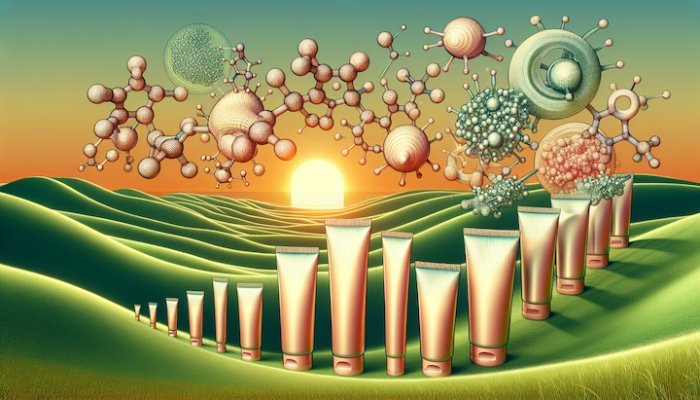Pimple and acne cream
Can progesterone provide the base for an effective pimple and acne cream?
Acne is an inflammatory disease of the skin which affects 85% of teenagers, most of whom are male. It can continue into adulthood.
Interestingly enough it rarely affects people outside the Western nations. According to Cordain et al there is an absence of acne in the Kitavan Islanders of Papua New Guinea and Ache hunter-gatherers of Paraguay. They believe this is due to their diets, which, being natural and unprocessed, have a much lower glycaemic index than Western diets. They are also more physically active than Westerners. They do not have insulin resistance, obesity, hypertension, diabetes, or heart disease.
Too much sugar, or foods in the diet which convert to glucose in the body, cause an increase in insulin and insulin resistance, leading to more sugar consumption.
This in turn causes androgens to increase, high androgens in turn cause acne.
The sebaceous glands are stimulated by androgens produced in the skin itself. Often elevated androgen levels are not found in blood or urine from patients with acne.
DHT (dihydrotestosterone) is made in the sebaceous glands from testosterone, through the action of 5 alpha-reductase. Progesterone inhibits 5 alpha-reductase.
In women it appears that DHT is made from androstenedione, the precursor to testosterone.
In searching for an effective pimple and acne cream it should be kept in mind that there are as many treatments as there are theories about what causes it. A few common factors have been found...
- A higher level of free testosterone. The levels of free testosterone in males is 9 to 30 ng/dL, and in females it's 0.3 to 1.9 ng/dL
- Increased level of the enzyme 5-alpha reductase. This converts the less potent androgens, such as testosterone and androsterone, into dihydrotestosterone (DHT), which has a greater effect on sebum production
- Adrenocorticotrophic hormone (ACTH) from the pituitary gland influences the adrenal gland, which produces the androgenic steroid dehydroepiandrosterone (DHEA)
- Higher levels of dehydroepiandrosterone (DHEA) are found in the sebaceous glands. This in turn is converted by 5-alpha reductase into DHT
- Dehydroepiandrosterone sulfate (DHEAS) is significantly and specifically associated with the initiation of acne in young girls
- Follicular hyperkeratosis or abnormal follicular keratosis
- Increased sebum production
- Bacterial infection by Propionibacterium acnes. Although P. acnes is a normal inhabitant of the skin, its levels are higher in patients with acne
- Sebum from patients with acne is deficient in linoleic acid
- Higher levels of insulin-like growth factor 1 (IGF-I)
- Acne-prone skin has been shown to be insulin resistant
- Adrenal hyperplasia
- A positive association has been found between acne and total milk intake. Probably because of the various hormones present
- d-Chiro-, myo-inositol and inositol increases the action of insulin, which decreases serum androgen concentrations, blood pressure, and plasma triglyceride concentrations.
Natural remedies, with special reference to progesterone as a potentially effective pimple and acne cream...
- Progesterone inhibits 5 alpha-reductase activity at high doses, studies show it has a local anti-androgenic action
- Progesterone also inhibits the production of androgens within the body
- Progesterone reverses follicular keratosis
- Progesterone causes a significant reduction in sebum excretion in women
- Zinc is a potent inhibitor of 5 alpha-reductase activity
- Vitamin B6 potentiates the inhibitory effect of zinc
- d-Chiro-inositol, myo-inositol and inositol help increase the action of insulin
- Azelaic acid is also a potent inhibitor of 5 alpha-reductase Type 1. It is a natural plant acid found in wheat, barley and rye. A 20% topical cream has been found to be effective against mild to moderate acne by reducing the activity of the bacteria Propionibacterium acnes and Staphylococcus epidermidis
- Both acne and insulin sensitivity improve after a low-glycaemic-load diet
- Phototherapy has been successful in treating acne, in particular intense violet light. When red visible light is added it works even better
- Supplementing with vitamin D is a cheaper option than phototherapy
- Vitamin D is essential for health, including skin health. Have a blood test done to check the level. The test should only be done for 25-hydroxyvitamin D, also called calcidiol
- 30-50% of people have a Vitamin D deficiency, particularly those living in climates with little sun, living above 32 degrees north or south of the equator, work indoors and spend little time in the sun. Levels should be between 50-100ng/mL or 124.80-249.60nmol/L. A deficiency is less than 25ng/L or 62.4nmol/L. For more information please see here
Any pimple and acne cream containing progesterone should enable usage levels of 100-200mg/day of progesterone. For information on how to use it please see here.
Before using progesterone it's essential to read the page on oestrogen dominance first. And here is an insight into the effects of contraceptives.
Nutrients
Please see the web page on insulin resistance for information on supplements to take.
In addition take daily 100mg zinc. This high dose should be taken for approximately three months, when the dose should be reduced to 15mg/day. Acne has often cleared after using a high dose zinc supplement, especially needed by men, as the sperm contains more zinc than any other part of the body.
It is beneficial for the skin to take 5ml Omega 3 fish oil and/or 15 to 60ml flax oil and 5ml GLA from evening primrose oil.
The probiotics are another essential for clear skin. Be sure to take a supplement containing at least 10 billion bacteria per dose.
Taking a parasite cleanse, digestive enzymes and betaine hydrochloride (HCl) to improve digestion, is something to consider.
Please see here for more information on Nutrition and Diet.
Acne drugs
- Finasteride is one of several inhibitors of 5 alpha-reductase that have been developed. These drugs selectively block dihydrotestosterone production and androgen action in the prostate and skin.
- Adrenal hyperplasia - low-dose corticosteroids may be added to reduce adrenal androgen precursors.
- The antiandrogen cyproteronacetate is an effective agent in the control of recalcitrant acne in males.
- Other androgen receptor blockers in use are spironolactone and flutamide
- Isotretinoin (13-cis retinoic acid), a drug derived from vitamin A, is used to treat severe nodular acne. It causes a dramatic decrease in androgen 5 alpha-reduction observed mainly in the skin.
- It must not be taken by women who are pregnant or likely to become so, as it causes miscarriages, premature births, birth defects in the foetus or causes the baby to die shortly after birth.
- A very small amount of isotretinoin can probably be present in the semen of men. It is not known if this small amount of isotretinoin may harm the foetus if a partner is or becomes pregnant.
- Isotretinoin and vitamin A suppresses vitamin D. Be extremely cautious about taking isotretinoin.
References
Clin Cosmet Investig Dermatol. 2012;5:135-40
Zinc ascorbate has superoxide dismutase-like activity and in vitro antimicrobial activity against Staphylococcus aureus and Escherichia coli
J Eur Acad Dermatol Venereol. 2010 Jul;24(7):763-7
Oxidative stress in acne vulgaris
Br J Dermatol. 2008 Nov;159(5):1086-91
Tissue and blood superoxide dismutase activities and malondialdehyde levels in different clinical severities of acne vulgaris
J Clin Invest. 2007 December 3; 117(12): 3979; 3987
Monosaccharide-induced lipogenesis regulates the human hepatic sex hormonebinding globulin gene
J Steroid Biochem. 1984 Jan;20(1):437-9
The effect of progesterone administration on sex hormone binding globulin binding capacity in women with severe premenstrual syndrome
J Drugs Dermatol. 2008 Jul;7(7 Suppl):s2-6
Topical vitamins
Exp Dermatol. 2008 August ; 17(8): 633&Mac226; 639
The vitamin D pathway: a new target for control of the skin&Mac226;Äôs immune response?
Experimental Dermatology Jun 2007, Volume 16 Issue 7, Pages 618 - 625
Vitamin D and the skin: an ancient friend, revisited
Medical Hypotheses Volume 69, Issue 5, 2007, Pages 1080-1084
Acne vulgaris: Nutritional factors may be influencing psychological sequelae
J Am Acad Dermatol. 2007 Aug;57(2):247-56. Epub 2007 Apr 19
The effect of a high-protein, low glycemic-load diet versus a conventional, high glycemic-load diet on biochemical parameters associated with acne vulgaris: a randomized, investigator-masked, controlled trial
International Journal of Dermatology 2007, Volume 34 Issue 6, Pages 434 - 437
Topical nicotinamide compared with clindamycin gel in the treatment of inflammatory acne vulgaris
Journal of the American Academy of Dermatology, Volume 52, Issue 2 , February 2005, Pages 360-362
High school dietary dairy intake and teenage acne
Semin Cutan Med Surg. 2005 Jun;24(2):84-91
Implications for the role of diet in acne.
International Journal of Cosmetic Science. 27(5):255-261, October 2005
Nicotinamide - biologic actions of an emerging cosmetic ingredient
Journal of Cosmetic Dermatology. 3(2):88-93, April 2004
Nicotinic acid/niacinamide and the skin
Arch Dermatol. 2002 Dec;138(12):1584-90
Acne vulgaris: a disease of Western civilization.
Archives of Dermatology Vol. 130 No. 3, March 1994
Acne vulgaris in premenarchal girls. An early sign of puberty associated with rising levels of dehydroepiandrosterone
Acta Derm Venereol. 1992;72(3):217-9
Serum levels of vitamin D metabolites in isotretinoin-treated acne patients
Obstetrics & Gynecology 1991;78:103-107
Effects of sex steroids on skin 5 alpha-reductase activity in vitro
G Ital Dermatol Venereol. 1990 Sep;125(9):363-7
[Sexual hormones and acne in adolescent women]
British Journal of Dermatology Volume 119 Issue 5 Page 627-632, Nov 1988
Inhibition of 5 alpha-reductase activity in human skin by zinc and azelaic acid
Archives of Dermatological Research Volume 276, Number 6 / September, 1984 Pages 401-405
The local antiandrogenic effect of the intracutaneous injection of progesterone in the flank organ of sexually mature male syrian golden hamster
Archives of Dermatological Research Volume 269, 281-290, Number 3 / December, 1980
Inhibition of testosterone metabolism and lipogenesis in animal sebaceous glands by progesterone
Acta Derm Venereol Suppl (Stockh). 1980;Suppl 89:27-31
The influence of sex hormones on acne.
British Journal of Dermatology Volume 100 Issue 6 Page 687-692, June 1979
The effect of topically applied progesterone on sebum excretion rate
California Medical Association Dermatology and Syphilology Section May 2-6, 1937
VITAMIN D IN ACNE
 Progesterone cream is a type of bio-identical hormone therapy (BHT). Unlike synthetic hormones, these mimic the body’s natural hormones, and are easily absorbed through the skin. Progesterone cream ca…
Progesterone cream is a type of bio-identical hormone therapy (BHT). Unlike synthetic hormones, these mimic the body’s natural hormones, and are easily absorbed through the skin. Progesterone cream ca… Struggling with weight gain or not being able to shed excess mass? If you have addressed your diet and exercise regime then you may want to look into the role hormones play in the arena of weight mana…
Struggling with weight gain or not being able to shed excess mass? If you have addressed your diet and exercise regime then you may want to look into the role hormones play in the arena of weight mana… Finding natural solutions to hormonal problems is a quest for many women worldwide. Organic progesterone creams emerge as a favoured choice offering a natural balance without the complications attache…
Finding natural solutions to hormonal problems is a quest for many women worldwide. Organic progesterone creams emerge as a favoured choice offering a natural balance without the complications attache…